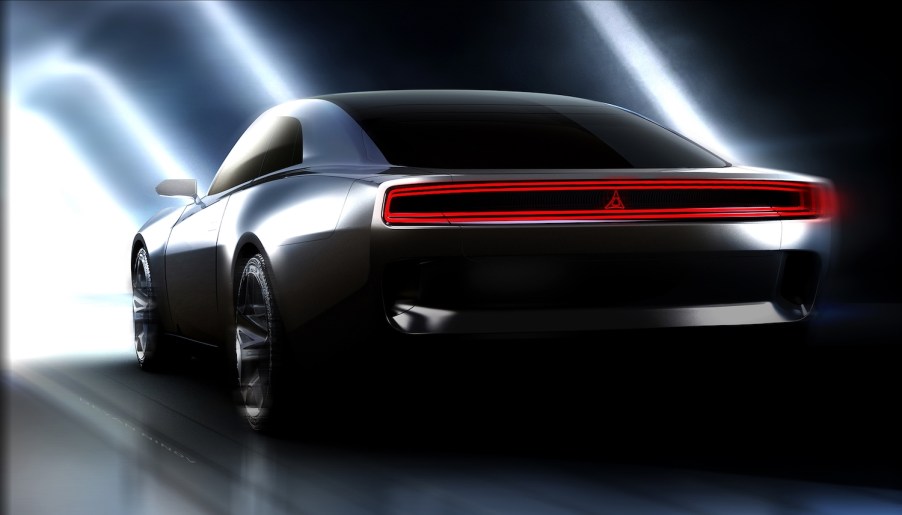
Dodge Can Do Better Than an Electric Hellcat
Electric cars and traditional internal combustion cars are very different vehicles with different strengths. For this reason, it holds electric cars back when automakers use internal combustion cars as benchmarks and try to set new EVs up as direct competitors. One obvious example is the way Dodge is setting its new SRT Banshee powertrain up as its Hellcat replacement. But multiple electric cars already produce Hellcat levels of power. Automakers such as Dodge will need to create something all new.
The Dodge Charger Daytona is a Hellcat-replacement

Dodge’s fully electric concept promises to drive the brand into the future: the Charger Daytona EV. This new “eMuscle” car is a masterpiece of retro-futuristic design. It boasts exciting new features like a pistol-grip “eRupt” shift lever and a functional front “R-wing” to retain the profile of a gasoline car’s hood. But the new vehicle’s performance numbers simply match the outgoing Charger.
The non-SRT trims of the Charger Daytona are targeting 455 horsepower and 590 horsepower, respectively. Owners can pay extra at the dealership to bump this output all the way up to 535 horsepower and 670 horsepower–respectively.
There is nothing wrong with these numbers–they certainly improve on the non-SRT V8-powered Chargers. But electric cars are also heavier and need more horsepower to match internal combustion acceleration. In addition, a multi-engine electric car’s horsepower rating is simply the maximum amount of power it can put to all its wheels in a situation with perfect traction.
Being able to replicate–or slightly improve on–internal combustion power output will not make Dodge’s eMuscle cars competitive. It will still need to compete with the 804 horsepower Lucid Air and the 1,020 horsepower Model S Plaid. And if it proves faster, its horsepower won’t prove as important as how it uses that power.
A Hellcat replacement will no longer shake up the market segment

Stellantis (Dodge’s parent company) is also promising a Hellcat replacement, the SRT Banshee powertrain. Looking at the Charger Daytona’s non-SRT power numbers, it is clear that the SRT Banshee will outperform the Hellcat, and the Redeye too. I expect the stock version to make around 909 horsepower. This would reserve 1,000 horsepower bragging rights for customers willing to pay the dealer for the aftermarket upgrade key.
These sort of performance numbers would put the new Dodge Charger Daytona on-par with the Tesla Model S Plaid–on a dynometer. But the Tesla Model S Plaid’s domination of the drag strip is due to more than its output. It leverages precise control of its battery temperature, motor temperature, and even its ride height to achieve a 2.1-second 0-60. Tesla has been slowly building a faster sedan over the past decade. If Dodge is going to beat this startup, it needs to pay attention to what Tesla is doing.
When Dodge released its first factory supercharged engine–the SRT Hellcat–it put the world on notice. Horsepower as high as 700 had previously been reserved for six-figure supercars. Dodge forged its fans into a brotherhood of muscle, and established itself as THE muscle car brand. But Dodge did this by redefining what the V8 engine could do.
If Dodge is to establish itself as the eMuscle brand, it must redefine what the electric sports car can accomplish. It will not be enough to build an electric Hellcat.
Dodge could make a faster Model S Plaid

Dodge revealed that its new SRT Banshee powertrain has an 800-volt capacity. This is rare among current EVs. It means this eMuscle car would be able to draw power from its battery faster than most EVs, and dump all that power into its motors. Even the Tesla Model S Plaid is still limited by its 400-volt system. This is a step in the right direction.
The Tesla Model S Plaid is also limited by having just three electric motors. The Rivian R1T has proven a market for quad-motor drive. MotorTrend revealed that when this 7,000-pound truck torque-vectors its way through a curve, it corners more like a sports sedan than a pickup. If Dodge pioneers the first 800-volt quad-motor system, it could dominate the market. But Dodge does not have to stop there.
The Tesla Model S Plaid weighs a beefy 4,766 pounds. This makes even the traditional Charger–with a weight of 3,900-4,500 pounds–look light. Much of the Model S’s weight is due to its Lithium Ion battery pack. If Dodge was serious about performance, it could lighten the Charger Daytona SRT’s battery, thus reducing its range. A gasoline-powered range extender, like Ram is developing for its electric truck, could make up the difference.



